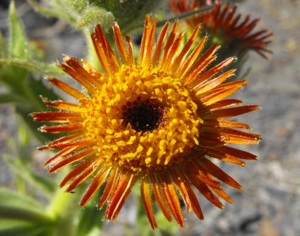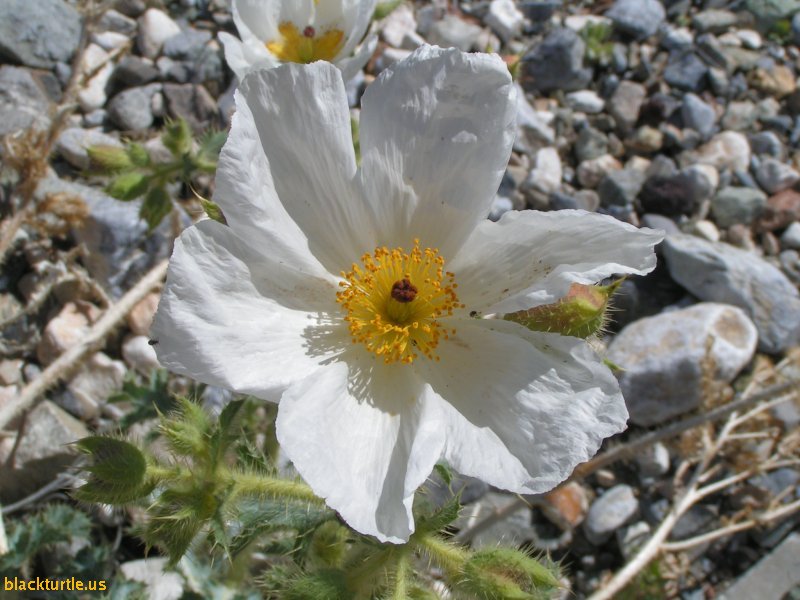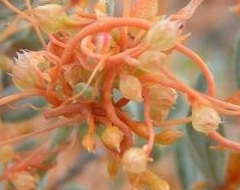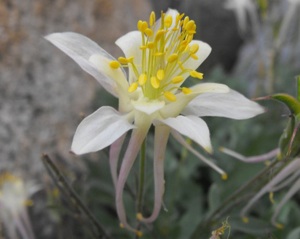|
|

|
Desert Mistletoe
January/February
This image shows a close up view of the berry of Desert Mistletoe
(Phoradendron californicum). There are a few members of the Mistletoe Family
(Viscaceae) that grow in the Death Valley area, but most mistletoes are
found growing at higher elevations. Desert Mistletoe is encountered at
elevations between 0 and 4000 feet. In fact, the picture displayed here was
taken near Hall Canyon on the floor of Panamint Valley.
(Click here for more info!)
|

|
Redray Alpinegold
March/April
Redray Alpinegold is particularly striking because of it's deep orange or
deep red flowers. The flowers have the typical daisy-like configuration
common to many members of the Sunflower Family (formerly known as the
Compositae, now known as the Asteraceae) with up to sixty ray flowers. The
only place I've encountered Redray Alpinegold is along the crest of the
Panamint Range between Porter Peak and Sentinel Peak. This happens to be the
location of the Happy Canyon Fire which occurred during July 2000.
(Click here for more info!)
|

|
Prickly Poppy
May/June
Prickly Poppy (Argemone corymbosa) is extremely common in the Death Valley
area. The large white flower is quite attractive, although the plant it
grows on, admittedly, does look a little weed-like, with its prickly leaves
and somewhat ragged appearance. Although prickly poppy is likely to be found
growing just about anywhere in the Death Valley area between 1200 and 4000
feet in elevation, it is particularly impressive near sand dunes where large
colonies of the plant sometimes occur.
(Click here for more info!)
|

|
Witch's Hair
July/August
Witch's Hair is just one of several common names -- including devil's guts,
goldthread, hairweed, angel hair, and a few others -- for what is usually
called dodder, or somewhat more formally Cuscuta. There are actually five
species of Cuscuta that grow in the Death Valley area. They are all yellow
or orange parasitic vines that suck the life out of other plants. Recently,
as a result of genetic analysis, Witch's Hair has been moved from the
Cuscutaceae to the Convolvulaceae, otherwise known as the bindweed or
morning glory family. Witch's Hair is quite common and in case you've never
seen it
(Click here for more info!)
|

|
Datura
September/October
Also known as Jimson Weed, as well as a few other names, this is one of the
most spectacular flowers found in the Death Valley area. Back in September
of 2006, I posted a video on YouTube featuring lots of close up shots of the
big white, trumpet-shaped flowers produced by this beautiful plant. The
video was called "Moonflower" and it is a parody of an old Cat Stevens song.
Datura is famous for it's hallucinogenic properties. However, the plant is
extremely poisonous and it's a really, really bad idea to attempt to
experience a cheap high by ingesting this plant!
(Click here for more info!)
|

|
Alpine Columbine
November/December
Probably the most spectacular wildflower that I was lucky enough to
photograph this last summer were some specimens of Alpine Columbine
(Aquilegia pubescens) observed while hiking in the Sierra Nevadas. Although
a close relative, Mojave Columbine (Aquilegia formosa), does grow within the
boundaries of Death Valley National Park, Alpine Columbine is not found
within park boundaries. The flowers of the two species of Columbine are
quite similar. Both have distinctive nectar spurs and the same overall
shape, but the most obvious difference is that Alpine Columbine is white and
Mojave Columbine is red.
(Click here for more info!)
|
|
| |
|

blackturtle.us
PLANT
BLOG
BLOG INDEX
ASSOCIATED SITES:
Trona News
Rusky Ed
Any Place Education








|

















